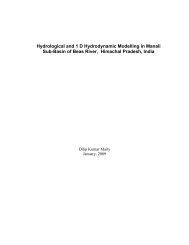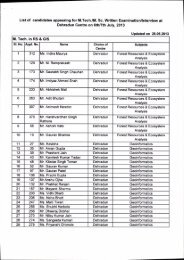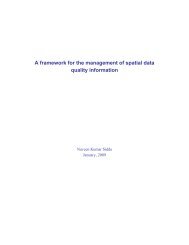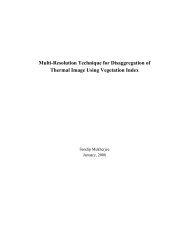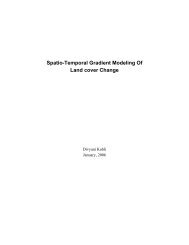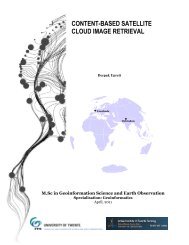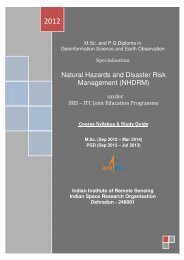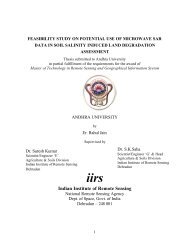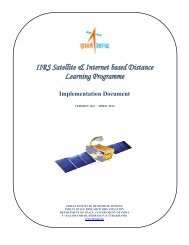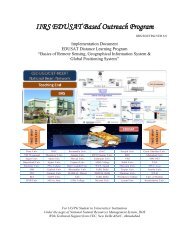Impact of Coal Mining on Vegetation: A Case Study in Jaintia Hills ...
Impact of Coal Mining on Vegetation: A Case Study in Jaintia Hills ...
Impact of Coal Mining on Vegetation: A Case Study in Jaintia Hills ...
You also want an ePaper? Increase the reach of your titles
YUMPU automatically turns print PDFs into web optimized ePapers that Google loves.
IMPACT OF COAL MINING ON VEGETATION: A CASE STUDY IN JAINTIA HILLS DISTRICT OF MEGHALAYA, INDIA3.3.3.1. Radiometric Correcti<strong>on</strong>First order correcti<strong>on</strong>s were d<strong>on</strong>e by dark pixel subtracti<strong>on</strong> technique followed by Lilles and Kiefer(1999).3.3.3.2. Visual Interpretati<strong>on</strong><strong>Study</strong><strong>in</strong>g changes <strong>in</strong> land use pattern us<strong>in</strong>g remotely sensed data is based <strong>on</strong> the comparis<strong>on</strong> <str<strong>on</strong>g>of</str<strong>on</strong>g> thetime sequential data. Differences <strong>in</strong> surface phenomen<strong>on</strong> over time can be determ<strong>in</strong>ed and evaluatedby visual <strong>in</strong>terpretati<strong>on</strong> with local knowledge (Garg et al., 1988; SAC, 1999). For the present purposevisual <strong>in</strong>terpretati<strong>on</strong> technique was used for land use/ land cover mapp<strong>in</strong>g for four different yearsremote sens<strong>in</strong>g data <str<strong>on</strong>g>of</str<strong>on</strong>g> the study area.3.3.3.3. Change AnalysisThe land use/ land cover maps <str<strong>on</strong>g>of</str<strong>on</strong>g> 1975, 1987, 1999 and 2001 were c<strong>on</strong>verted <strong>in</strong>to grid format us<strong>in</strong>gIntergraph MGE Grid Analyst. Maps <str<strong>on</strong>g>of</str<strong>on</strong>g> different time periods were overlaid to f<strong>in</strong>d changes. The<strong>in</strong>crease or decrease <strong>in</strong> different land use/ land cover is obta<strong>in</strong>ed by <strong>in</strong>tersect<strong>in</strong>g and generat<strong>in</strong>g thematrices <str<strong>on</strong>g>of</str<strong>on</strong>g> change-no change for different years.3.3.3.4. Forest Fragmentati<strong>on</strong> AnalysisIt was measured by calculat<strong>in</strong>g the amount <str<strong>on</strong>g>of</str<strong>on</strong>g> forest patches occurr<strong>in</strong>g <strong>in</strong> a landscape with respect t<strong>on</strong><strong>on</strong>-forest patches. In the programme, Bio_CAP the area was reclassified <strong>in</strong>to three categories viz.,n<strong>on</strong>-forest, high fragmentati<strong>on</strong> and low fragmentati<strong>on</strong>.3.3.3.5. Phytosociological AnalysisThe community characteristics <str<strong>on</strong>g>of</str<strong>on</strong>g> vegetati<strong>on</strong> <strong>in</strong> coal m<strong>in</strong><strong>in</strong>g areas <str<strong>on</strong>g>of</str<strong>on</strong>g> Ja<strong>in</strong>tia <strong>Hills</strong> district <str<strong>on</strong>g>of</str<strong>on</strong>g> Meghalayawere studied dur<strong>in</strong>g the last week <str<strong>on</strong>g>of</str<strong>on</strong>g> October, 2004. To f<strong>in</strong>d out the impact <str<strong>on</strong>g>of</str<strong>on</strong>g> coal m<strong>in</strong><strong>in</strong>g <strong>on</strong>vegetati<strong>on</strong> distant gradient analysis was carried out. In this method, from the center <str<strong>on</strong>g>of</str<strong>on</strong>g> the study area,i.e., Lad Rymbai, structure and compositi<strong>on</strong> <str<strong>on</strong>g>of</str<strong>on</strong>g> vegetati<strong>on</strong> is observed <strong>in</strong> four different z<strong>on</strong>es. Theradius <str<strong>on</strong>g>of</str<strong>on</strong>g> the first circle i.e., z<strong>on</strong>e-I is 2 km. The distance from the periphery <str<strong>on</strong>g>of</str<strong>on</strong>g> the first circle to theperiphery <str<strong>on</strong>g>of</str<strong>on</strong>g> the sec<strong>on</strong>d circle is also 2 km and is c<strong>on</strong>sidered as z<strong>on</strong>e-II. Likewise, z<strong>on</strong>e-III and z<strong>on</strong>e-IV are del<strong>in</strong>eated (Figure 3.5). In each circle 24 sample plots each for tree, shrub and herbs were laid.Each sample plot was supported by 3 replicas. The total number <str<strong>on</strong>g>of</str<strong>on</strong>g> sample plots for tree, shrub andherbs came to 72 each <strong>in</strong> each z<strong>on</strong>e. The overall number <str<strong>on</strong>g>of</str<strong>on</strong>g> sample plots for tree, shrub and herbspecies was 288 each <strong>in</strong> the m<strong>in</strong><strong>in</strong>g areas, i.e., <strong>in</strong> all the four z<strong>on</strong>es. The vegetati<strong>on</strong> characteristics <str<strong>on</strong>g>of</str<strong>on</strong>g>the m<strong>in</strong>ed areas were compared with that <str<strong>on</strong>g>of</str<strong>on</strong>g> an adjacent undisturbed forest, i.e., Tubre Sacred Grove.The total number <str<strong>on</strong>g>of</str<strong>on</strong>g> quadrats laid <strong>in</strong> the c<strong>on</strong>trol site was 10.For tree comp<strong>on</strong>ent a quadrat <str<strong>on</strong>g>of</str<strong>on</strong>g> 10m x 10m size was laid while for the shrub species it was 5m x 5m.For the herbaceous species the size <str<strong>on</strong>g>of</str<strong>on</strong>g> the quadrat was 1m x 1m. The species found <strong>in</strong> the quadratswere identified with the help <str<strong>on</strong>g>of</str<strong>on</strong>g> the herbaria <str<strong>on</strong>g>of</str<strong>on</strong>g> Botany Department, North-Eastern Hill University,Shill<strong>on</strong>g and Botanical Survey <str<strong>on</strong>g>of</str<strong>on</strong>g> India, North-Eastern Circle, Shill<strong>on</strong>g. The plants hav<strong>in</strong>g CBH>15cm was c<strong>on</strong>sidered as tree, stem diameter 5-15cm at basal level was c<strong>on</strong>sidered as shrubs and stemdiameter



